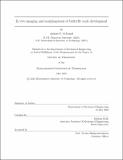| dc.description.abstract | During metamorphosis, the wings of a butterfly sprout hundreds of thousands of scales with intricate micro- and nanostructures that determine the wings' optical appearance, wetting characteristics, thermodynamic properties, and aerodynamic behavior. This strategy—of enabling multifunctionality by controlling material structure across relevant length scales—can be emulated in bioinspired materials. However, the range of structural length scales that are integrated in biological materials exceeds that of their synthetic counterparts, due in large part to our limited understanding of the processes that biology employs in their formation. Key to gaining deeper insights into these processes is the visualization of material structures as they form within the living organism.
In this thesis, I present an approach for studying structure formation in wing scales of live butterflies with high temporal and spatial resolution. To gain a comprehensive perspective of scale formation, I developed pupal surgery techniques and adapted quantitative phase microscopy methods to achieve label-free, in vivo visualization of scale cell growth in Vanessa cardui pupae throughout pupal development. This continuous visualization of scale cells establishes a clear phenomenological timeline of scale morphogenesis that was previously limited by the discrete nature of ex vivo studies of fixed cells. Moreover, by capturing time-resolved volumetric tissue data together with nanoscale surface height information, we gain quantitative insights into the underlying processes involved in scale cell patterning and growth.
The quantitative data from live imaging informs a continuum mechanics model of the growth of the scales' ridge structures and allows examination of the structural requirements for proper ridge formation. Live imaging of structure formation also leads to unique broader impacts, including approaches for exploiting human perception of color to visualize overlapping structures in volumetric data, and hands-on learning activities in the classroom and laboratory centered around bio-optics, structure formation in nature, and butterfly surgery. In vivo visualization of butterfly scale cell morphogenesis offers a rich foundation for deciphering biological processes and biomechanical principles involved in the formation of functional materials and for engaging broader audiences. | |
